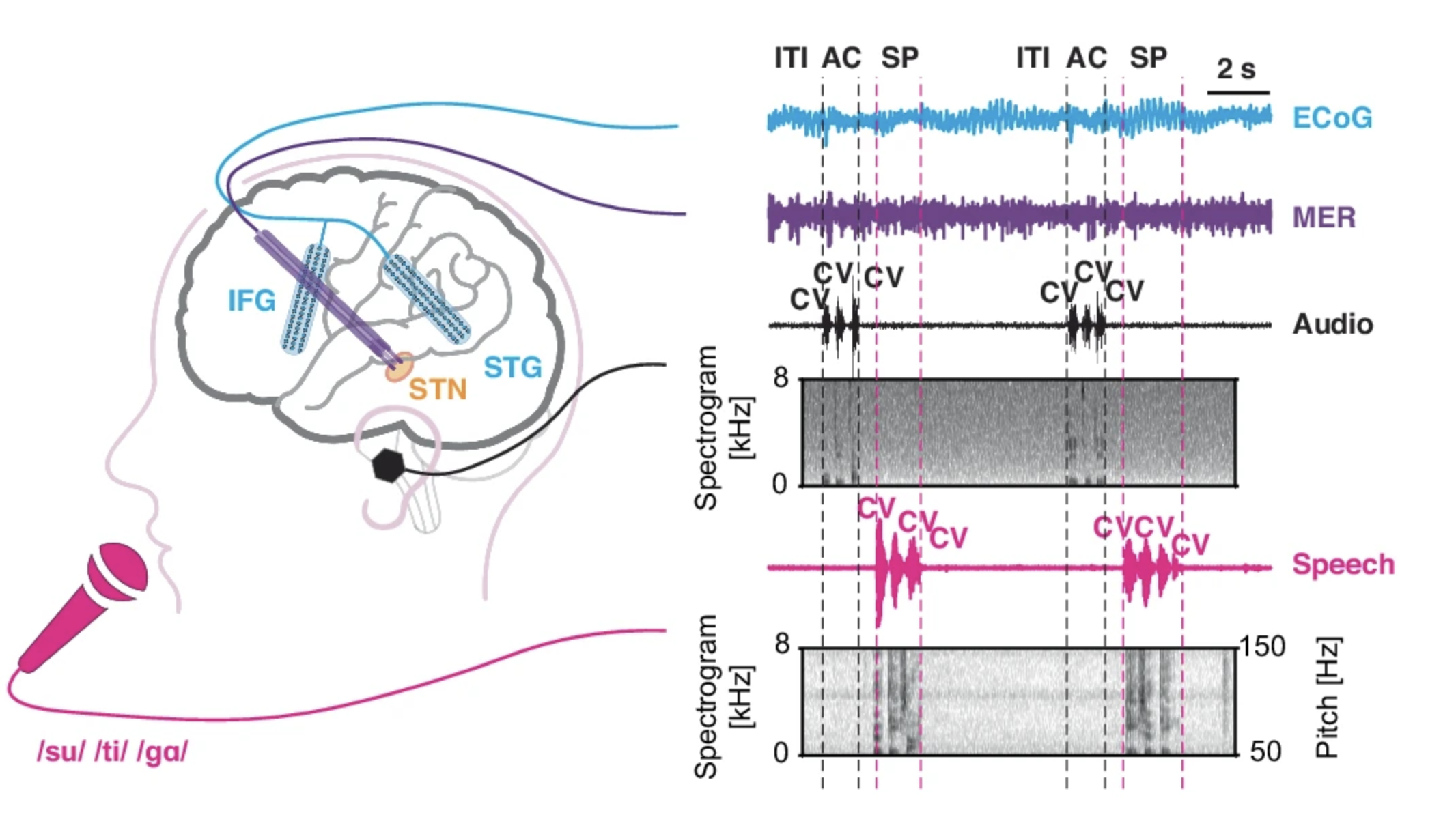Synchrony in Speech: Revealing How Deep Brain Regions Communicate During Speaking
Published in Neuroscience

Speech allows us to share thoughts, feelings, and ideas effortlessly. Despite its apparent simplicity in everyday life, speech production involves incredibly precise coordination between different areas of the brain.
For decades, researchers have primarily focused on the outer layers of the brain, known as the cerebral cortex, believing it held the keys to understanding speech production. Yet, what about the deeper, less explored regions of our brain?
This question drove our curiosity. Specifically, we wondered about a small, almond-shaped structure deep within the brain known as the subthalamic nucleus (STN), a part of the basal ganglia. The basal ganglia have traditionally been associated with movement control, decision-making, and reward processes. Could this region also be critical for speech?
A rare opportunity
Studying deep brain regions in humans is inherently challenging. Typically, this requires invasive techniques only ethically permissible when patients undergo neurosurgery for therapeutic reasons, such as deep brain stimulation treatment for Parkinson’s disease or epilepsy surgery. Such procedures offer a rare and invaluable chance to record directly from deep brain structures while patients are awake and interacting.
Thanks to an interdisciplinary collaboration involving neurosurgeons, neurologists, and neuroscientists, our team seized this unique opportunity. We were able to simultaneously measure brain activity from two areas: the cortical surface and deep within the subthalamic nucleus itself. Patients who participated were awake and comfortable during surgery, performing simple speech tasks such as repeating syllables. This extraordinary setup allowed us to observe the interactions between these two brain regions in real-time.

Capturing synchrony in the brain
What we discovered was remarkable: precise timing and synchrony between the firing of neurons in the subthalamic nucleus and rhythmic oscillations (brainwaves) in cortical areas essential for speech processing. Imagine the brain as an orchestra, where each section must play at exactly the right moment. In our analogy, the subthalamic nucleus functions as a conductor, coordinating timing signals essential for speech accuracy.
We found these critical interactions specifically occurred within the theta-alpha frequency (4-12 Hz) band—rhythms associated with communication and cognitive processes. Importantly, these brief moments of neural synchronization (lasting only around 200 milliseconds) were closely tied to successful speech sounds.

Whenever there were delays or disruptions in this synchronization, patients tended to make speech errors—such as omitting or substituting sounds. These findings provided compelling evidence that accurate speech depends heavily on well-timed communication between cortical and subcortical brain regions.

Rethinking speech production
These results challenge traditional views that speech primarily relies on cortical brain regions. Instead, our study highlights the critical role of deeper brain structures, emphasizing the subthalamic nucleus as a vital part of speech production circuits.
We speculate that these subcortical-cortical interactions help the brain manage auditory-motor transformations—the process by which we hear a sound and translate it into movements of our vocal muscles—or maintain phonological working memory, which temporarily holds information about speech sounds during planning and production.
Broader implications
Understanding the subthalamic nucleus's role in speech production doesn't just expand our basic scientific knowledge; it opens potential new avenues for therapeutic interventions. For instance, speech impairments commonly accompany neurological disorders such as Parkinson’s disease, stroke, and certain psychiatric conditions. Improving our understanding of subcortical involvement could enhance treatment approaches like deep brain stimulation, which is already effectively used to treat movement disorders.
Our work also underscores the importance of interdisciplinary collaboration. Neurosurgeons, neurologists, neuroscientists, and even patients themselves—each played an indispensable role. This collective effort was crucial, reminding us that scientific breakthroughs often emerge at the intersection of different fields.
Behind the scenes: the human element
One of the most profound aspects of this research journey was interacting with patients who bravely contributed to science during their own therapeutic procedures. Their willingness to participate, often driven by a desire to help others in the future, was deeply inspiring.
Throughout this process, we were also reminded how important communication is—not just in speech, but also within science itself. Clear communication between scientists, clinicians, and patients is essential, creating trust and fostering discoveries that can genuinely improve lives.
Looking ahead
This study represents an exciting first step toward fully understanding how our brain orchestrates speech. Future research can explore additional subcortical regions and their precise roles in speech production. Moreover, integrating these findings with advanced computational models could help simulate speech disorders and test new interventions virtually before clinical trials.
We are also intrigued by potential parallels between speech and other behaviors influenced by subcortical-cortical interactions. Could similar timing mechanisms underpin other complex tasks, such as playing a musical instrument, coordinated physical movements, or decision-making? Answering these questions may further illuminate the profound importance of these deep brain regions.
This research journey started with simple curiosity about a deep brain structure previously overlooked in the context of speech. It transformed into a collaborative endeavor that has reshaped how we think about the brain’s complexity and coordination. Most importantly, this work underscores that sometimes, major insights lie just beneath the surface—literally and metaphorically—waiting for the right moment to be uncovered.
Follow the Topic
-
Nature Communications

An open access, multidisciplinary journal dedicated to publishing high-quality research in all areas of the biological, health, physical, chemical and Earth sciences.
Your space to connect: The Psychedelics Hub
A new Communities’ space to connect, collaborate, and explore research on Psychotherapy, Clinical Psychology, and Neuroscience!
Continue reading announcementRelated Collections
With Collections, you can get published faster and increase your visibility.
Women's Health
Publishing Model: Hybrid
Deadline: Ongoing
Advances in neurodegenerative diseases
Publishing Model: Hybrid
Deadline: Dec 24, 2025



Please sign in or register for FREE
If you are a registered user on Research Communities by Springer Nature, please sign in